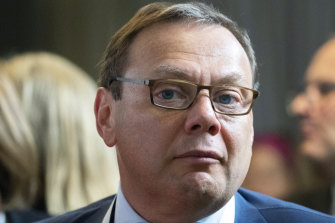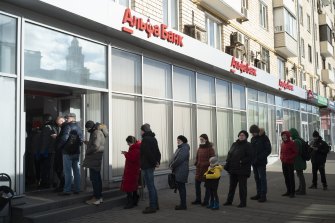The nonprofit has pledged about $US650 million to fight the disease, while also betting on early-stage cancer research companies. That’s added one more layer of protection to Knaster’s fortune and distanced him from his past at a time of sweeping sanctions on those affiliated with Russian wealth.
“From a strategic standpoint, he made a brilliant move to put his assets into this philanthropic foundation,” says US academic David Lingelbach, who headed Bank of America’s Russian operations in the 1990s and had dealings with Knaster. “I bet Mikhail Fridman wishes he’d done something like that.”

Knaster was described as Russian billionaire Mikhail Fridman’s “right arm” at one point.Credit:AP
Knaster declined to comment through a spokesperson.
Money trail
Like others close to Russian money, Knaster can’t entirely scrub the origins of his fortune, about half of which is tied up in Pamplona. His rise from mid-ranking bank executive to private equity power player, owner of an Italian football club and philanthropist is due — at least in part — to him being in the right place at the right time: Moscow in the freewheeling early post-Soviet years.
After attending Harvard Business School, where he studied alongside future billionaires including York Capital’s Jamie Dinan and businesswoman Thai Lee, Knaster turned to investment banking, with stints in London and New York for Deutsche Morgan Grenfell, Bankers Trust Co. and Simmons & Co.
Loading
In the mid-1990s he ended up back in his birthplace. As Russia opened to Western financiers, Knaster became head of Credit Suisse First Boston’s local operations. CSFB was a powerful player in the Moscow banking market and Knaster, among the firm’s biggest earners, made important contacts there.
The move turbocharged his career and in 1998 he was appointed chief executive officer of Fridman’s Alfa Bank. As the country’s financial crisis unfolded, he took a lead role in helping the lender sort out its debt problems, according to a person involved at the time.
Quickly establishing himself as an invaluable adviser to the oligarch and his inner circle, he was rewarded with a stake in an Alfa holding company that had investments in oil giant TNK-BP, Alfa Bank itself and telecoms company Turkcell Iletisim Hizmetleri. Knaster received more than $US50 million in dividends from his Alfa holding between 2001 and 2008, according to Bloomberg’s wealth index.
In 2004 he stepped down at Alfa Bank and founded London-based Pamplona, which would go on to manage nearly a third of Fridman and other Alfa Group executives’ wealth. It would also mint Knaster a fortune.
Pamplona was set up with nearly all of its private equity funds coming from Fridman, Aven and Khan. When most of a firm’s backing is from a single source, that investor usually negotiates lower fees and a bigger profit share.

In 1998, Knaster was appointed chief executive officer of Fridman’s Alfa Bank. Credit:AP
Not in this case. Knaster, a savvy negotiator, secured the high fees typical for a private equity firm with multiple backers, according to a person familiar who said the terms were “exceptionally good.”
Buyout groups typically charge a 2 per cent fee on the capital they manage, and 20 per cent of any profit from deals. For Knaster this meant he could make millions of dollars a year in guaranteed income. Pamplona oversaw about $US750 million of Knaster’s money at the end of 2021, according to Bloomberg’s wealth index.
“I always thought of Pamplona as a vehicle for managing some of Fridman’s wealth,” says Lingelbach, now a professor of entrepreneurship at the University of Baltimore. “It never in my judgment felt to be an independent entity per se.”
A Knaster spokesperson said that Pamplona also started hedge funds that had little or nothing to do with Alfa and LetterOne, that its fees were market rate and that the oligarchs made follow-on investments in Pamplona because they were impressed by the strong returns delivered by Knaster’s team on its initial fund.
His story is a remarkable example of just how much wealth has been accrued by advisers, managers and facilitators for the men who bought Russian state assets for peanuts in the 1990s and sold them at vast profit. It’s also an illustration of how hard severing connections can be.
Knaster was also called upon to advise on other important Alfa-LetterOne transactions. This included the 2013 sale of TNK-BP that netted $US14 billion for Fridman, Aven, Khan and Kuzmichev. Knaster was one of the architects of the deal and got a LetterOne stake worth about $US500 million at the time, according to people with knowledge of the matter.
Charitable mission
The year after negotiating TNK-BP’s sale, Knaster was hit by personal tragedy when his father died of cancer. That prompted him to set up the Mark Foundation in 2014. He transferred his stakes in LetterOne and Alfa Bank’s owner, ABH Holdings, to a holding entity for the foundation the same year, according to a person familiar with the matter, who asked not to be identified as the details aren’t public.
Loading
Since then it has received more than $US171 million, most of it directly from Knaster and only about 10 per cent through LetterOne and ABH dividends, the person said.
The value of the foundation’s stakes in LetterOne and Alfa Bank’s owner are significantly less than their book value as they are minority positions in closely held, illiquid companies, a spokesperson for Knaster said.
Days before Russia’s invasion of Ukraine — the birthplace of Knaster’s wife — as tensions were ramping up, he committed to add $US500 million more to the foundation.
Some of the nonprofit’s venture bets have already paid off, including an early investment in cancer-test provider Grail, which was acquired by Illumina for $US8 billion in 2021. It has also invested in biopharmaceutical company Immunitas Therapeutics, as well as biopsy-technology firm C2i Genomics and cell reprogramming startup Interius Biotherapeutics.
In a sign of the foundation’s importance to Knaster, he’s working on a master’s degree in molecular biology to go with his economics PhD from the Russian Academy of Science and Harvard MBA.
Loading
Alongside his charity work and ownership of Pisa Sporting Club, Knaster is also involved in new money-spinning ventures. He’s teamed up with fellow Harvard alumni and Milwaukee Bucks co-owner Dinan and hedge fund manager Edward Eisler to launch a special purpose acquisition company looking for sports opportunities.
He doesn’t appear to have lost his knack for dealmaking. The Cayman Islands-based company that represents him and the other SPAC sponsors paid less than $US25 million in total for its stake. It’s now worth about $US80 million.
Bloomberg
The Business Briefing newsletter delivers major stories, exclusive coverage and expert opinion. Sign up to get it every weekday morning.
For all the latest Business News Click Here
For the latest news and updates, follow us on Google News.
